Abstract
Additively manufactured maraging steel components often require surface engineering to achieve superior wear resistance for demanding industrial applications. This study investigates 18Ni300 maraging steel manufactured by Laser Powder Bed Fusion (L-PBF), comparing non-aged and pre-aged (480 °C × 6 h) specimens to systematically analyze the effects of nitriding duration (0 h, 24 h, 48 h, 60 h) on nitride layer microstructure, hardness, and wear resistance. Results show that the non-aged specimen, with its supersaturated solid solution matrix, exhibits slower nitride layer growth; a thin, dense nitride layer formed after 24 h of nitriding minimizes the wear depth (−9.043 μm) for optimal friction reduction. In the pre-aged specimen, matrix refinement, through intermetallic compound precipitation, enables a 211 μm nitride layer to form after 48 h of nitriding, elevating surface hardness to 650 HV, and creating a gradient structure (“high-hardness surface + strengthened matrix”), which yields the narrowest and shallowest wear scars and superior wear resistance. The experiments demonstrate that nitriding processes must align with matrix states; 24 h nitriding suits non-aged steel, while 48 h is optimal for aged steel, providing critical guidance for optimizing surface strengthening in additively manufactured 18Ni300 steel.
1. Introduction
The 18Ni300 maraging steel is extensively employed in critical sectors like aerospace precision components, high-precision injection molds, and racing engines’ connecting rods, owing to its outstanding mechanical properties, including a tensile strength of at least 2000 MPa and an elongation of at least 8%, coupled with good corrosion resistance [,]. While the traditionally cast 18Ni300 steel exhibits a uniform microstructure, the efficiency of forming complex components is low and the cost is high. Laser Powder Bed Fusion (L-PBF) technology achieves the high-precision forming of complex metal components through layer-by-layer melting, significantly improving the material utilization [,]. Nevertheless, the extremely high cooling rates (ranging from 103 to 108 K/s) inherent in the L-PBF process can cause elemental segregation, porosity defects, and the enrichment of residual austenite within the molten pool, leading to a reduction in surface hardness (typically 10–15% lower than that of forged parts) and a degradation in the friction and wear performance [,,].
Researchers worldwide have explored various surface modification techniques to enhance the surface properties of parts fabricated by Laser Powder Bed Fusion (L-PBF). In the field of nitriding treatment, plasma nitriding [] and gas nitriding [,] can significantly improve surface hardness and fatigue performance. Specially, Bai et al. found that the best nitriding process for 18Ni300 maraging steel involves 480 °C gas nitriding for 48 h, by comparing gas nitriding and ion nitriding processes []. In terms of heat treatment, Men, through different experiments, revealed that SLM 18Ni300 undergoes various microstructural changes during solution aging and direct aging treatments []. In [], the analysis of the phase, microstructure, and mechanical properties of SLM 18Ni300 steel samples in different heat treatment states indicated that aging and solution treatments significantly improved the strength and hardness of the samples but reduced the toughness and plasticity. Additionally, Han et al. found that as the aging time increases, the hardness and strength of the samples gradually increase to a peak and then decrease, while the elongation continues to increase [].
Although important progress has been made, according to the research mentioned above, existing studies remain fragmented and lack a comprehensive optimization framework for the microstructure and wear resistance of LBPF-formed 18Ni300 steel under combined heat treatment and nitriding. In this paper, the synergistic effects of nitriding time (24–60 h) and heat treatment on the surface hardness, nitride layer thickness, and tribological behavior of LBPF-formed 18Ni300 steel are systematically investigated. By combining EDS elemental distribution and SEM wear morphology analysis, the mechanism of surface strengthening via nitriding is elucidated, providing theoretical support for the surface engineering applications of LBPF-formed maraging steel.
2. Materials and Methods
2.1. Experimental Materials
The material employed in this study was 18Ni300 maraging steel powder, fabricated via vacuum gas atomization by Jiangsu Vilory Advanced Materials Technology Co., Ltd. (Xuzhou, China). The powder had a particle size distribution of 25–53 μm and an apparent density of 4.18 g/cm3, and its main chemical composition (mass fraction, %) is shown in Table 1. A laser powder bed fusion (L-PBF) machine (Model: DMP Flex350, GF Machining Solutions, Losone, Switzerland) was employed in the experiment, with argon gas of 99.9% purity introduced during the process. The key L-PBF processing parameters for 18Ni300 were as follows: a laser power of 280 W, laser scanning speed of 1000 mm/s, single-layer thickness of 30 μm, and a scanning spacing of 100 μm. The LPBF-fabricated samples were separated from the substrate via wire electrical discharge machining (WEDM). Subsequently, the LPBF-formed 18Ni300 steel was polished with 120-mesh, 600-mesh, and 1000-mesh sandpapers, sequentially. Finally, the samples were placed in a JM-60ST ultrasonic cleaner (Shenzhen Jiemeng Technology Co., Ltd., Shenzhen, China) and cleaned with absolute ethanol to remove oil and impurities.

Table 1.
Chemical composition of L-PBF 18Ni300 powder (wt.%).
2.2. Experimental Methodology
The samples were divided into two groups for the experiment.
Non-aged specimens were directly subjected to nitriding treatment; they were placed in a tubular vacuum furnace (Model: YTGKD205-11, Shanghai Yituo Technology Co., Ltd., Shanghai, China). The vacuum pump was activated to evacuate the tube to a vacuum state of 50 Pa, after which ammonia gas (NH3) was continuously fed into the tube to facilitate nitriding treatment, with the internal tube pressure maintained at 500 Pa and the furnace temperature at 500 °C. The nitriding times were 0 h, 24 h, 48 h, and 60 h, respectively.
Pre-aged specimens first underwent an aging heat treatment in a ceramic fiber muffle furnace (Model: MF-0914P, Huagangtong Technology (Beijing) Co., Ltd., Beijing, China). The specific parameters were as follows: holding at 480 ± 6 °C for 6 h (with a tolerance of −0/+30 min), followed by cooling down to room temperature along with the furnace. After that, the nitriding treatment was performed on these specimens, and the nitriding method was consistent with that used for the non-aged specimens.
2.3. Sample Characterization
The metallographic structure of the samples was examined using a Leica DMI8C optical microscope (Leica Microsystems GmbH, Wetzlar, Germany). Microstructural analysis and elemental composition characterization were carried out via a JEOL JSM-IT500 hR scanning electron microscope (SEM) (JEOL Ltd., Tokyo, Japan) equipped with an energy-dispersive spectroscopy (EDS) detector. Cross-sectional hardness measurements were obtained using a ZUANSHI-100VX Vickers hardness tester (ZUANSHI, Laizhou, China) under a load of 300 g and with a dwell time of 15 s.
Tribological performance was evaluated using an HT100 ball-on-disk friction (ZHONGGKEKAIHUA, Lanzhou, China) and a wear tester under the following conditions: a normal load of 10 N, a rotational speed of 1000 rpm, a wear track radius of 3 mm, and a ZrN counterpart ball (5 mm diameter). Tests were conducted for 60 min. Post-test wear scar morphology was analyzed using the optical microscope and a Bruker Contour GT-K 3D optical profilometer (Bruker, Tucson, AZ, USA). The volumetric wear loss (W) was calculated as follows:
where V is the wear volume (mm3), F is the applied load (N), and S is the total sliding distance (m).
3. Results and Analysis
3.1. Microstructure
3.1.1. Microstructure of the Non-Aged Specimen
The cross-sectional metallographic structures and EDS analysis results of nitrided samples are presented in Figure 1. In the figure, (a), (b), (c), and (d) are the un-nitrided sample, the sample nitrided for 24 h, the sample nitrided for 48 h, and the sample nitrided for 60 h, respectively.
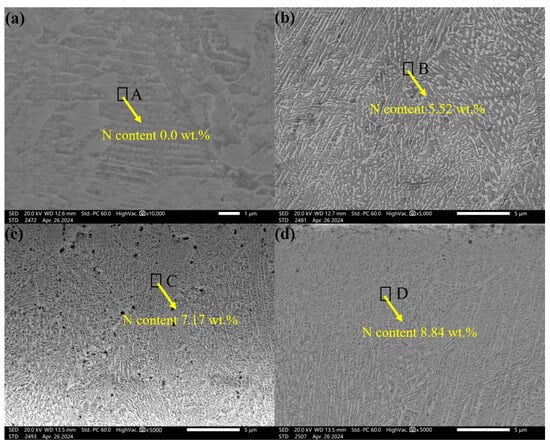
Figure 1.
SEM images of the nitrided layer on non-aged L-PBF manufactured 18Ni300 samples: (a) 0 h nitriding; (b) 24 h nitriding; (c) 48 h nitriding; and (d) 60 h nitriding.
Analysis reveals that un-nitrided samples (0 h) exhibit a smooth surface morphology without detectable nitride layers (Figure 1a), as confirmed by EDS analysis (area A in Figure 1a, N content = 0.0 wt.%). After 24 h of nitriding, a thin and dense nitrided layer forms (the content of N element in area B is 5.52 wt.% in Figure 1b), characterized by distinct acicular structures (Figure 1b). Extending nitriding to 48 h results in the significant thickening of the nitride layer with enhanced microstructural density (Figure 1c), suggesting the increased precipitation of alloying element nitrides (the content of N element in area C is 7.17 wt.% in Figure 1c). The black phase in the figure is micro-pores, which may result from gas entrapment during the rapid diffusion of nitrogen atoms or volume changes caused by phase transformations in the nitride layer. Prolonged nitriding for 60 h further increases the layer thickness (the content of N element in area D is 8.84 wt.% in Figure 1d) but induces microstructural coarsening (Figure 1d), indicating potential surface embrittlement.
Moreover, Figure 2 displays the surface scanning results of the sample after 60 h of nitriding. Following this prolonged nitriding treatment, the N element exhibits a uniformly enriched distribution in the surface layer, showing a complementary relationship with the distribution trends of Fe, Ni, and Mo elements (the N-enriched zones correspond to a sparser distribution of matrix elements). This indicates that an extended nitriding duration facilitates uniform nitrogen diffusion in the surface layer, where N preferentially bonds with strong nitride-forming elements such as Ti and Cr, forming a continuous nitride-strengthened layer. This microstructure provides the material foundation for enhanced surface wear resistance.


Figure 2.
The surface scanning results of the sample after 60 h of nitriding.
The metallographic structures of the cross-sections for non-aged L-PBF manufactured 18Ni300 samples after different nitriding durations are displayed in Figure 3. For the sample without nitriding (0 h, Figure 3a), the typical fusion channel structure is clearly observable. After 24 h of nitriding (Figure 3b), a nitrided layer with a thickness of approximately 79 μm forms on the surface, and the fusion channel structure starts to blur. When the nitriding duration extends to 48 h (Figure 3c), the nitrided layer depth increases notably to about 212 μm, and the original fusion channel structure almost disappears. Upon the further prolongment of nitriding to 60 h (Figure 3d), the nitrided layer depth shows a slight increase to around 238 μm, while the microstructure within the nitrided layer becomes more homogeneous.

Figure 3.
Metallographic structures of non-aged L-PBF manufactured 18Ni300 samples (a) 0 h nitriding; (b) 24 h nitriding; (c) 48 h nitriding; and (d) 60 h nitriding.
3.1.2. Microstructure of the Pre-Aged Specimen
After the aging heat treatment and nitriding treatment, the metallographic structures of the cross-sections of various samples are shown in Figure 4. Compared with the non-aged sample, as is shown in Figure 3a, it can be seen from the results that after the aging heat treatment, the typical fusion channel structure inside the sample is still vaguely visible but appears less distinct than that in the non-aged as-built state. After the nitriding treatment, similarly to in the non-aged specimen, the fusion channel structure disappears. After 24 h of nitriding, a nitrided layer of approximately 81 μm thickness appears on the sample surface, which is slightly thicker than the ~79 μm layer in the non-aged 24 h nitrided sample. After 48 h of nitriding, the depth of the nitrided layer increases significantly to about 211 μm, showing a slight difference from the ~212 μm measurement in the non-aged 48 h nitrided sample. When the nitriding time is further extended to 60 h, the depth of the nitrided layer increases slightly to about 231 μm, which is thinner than the ~238 μm measurement in the non-aged 60 h nitrided sample.

Figure 4.
Metallographic structures of L-PBF manufactured 18Ni300 after different heat treatments: (a) aging heat treatment; (b) aging heat treatment +24 h nitriding; (c) aging heat treatment +48 h nitriding; and (d) aging heat treatment +60 h nitriding.
The analysis of the pre-aged specimen reveals that, under nitriding conditions of 500 °C and 500 Pa pressure, ammonia decomposes into nitrogen and hydrogen, and that nitrogen primarily reacts with the Fe element in 18Ni300 at high temperatures to form an Fe-N solid solution, which appears darker than the matrix after etching. Since material nitriding mainly involves the reaction of N elements with the Fe element in the matrix material under the action of temperature and pressure, once a nitrided layer (solid solution) forms on the material surface, the thickness of the nitrided layer will become increasingly deeper over time when the temperature and pressure are constant []. However, when the thickness of the nitrided layer reaches a certain level (about 200 μm), the material nitriding effect diminishes due to the greater resistance to element diffusion of the nitrogen-rich solid solution []. Notably, pre-aged samples exhibit a slightly different nitrided layer growth trend compared to their non-aged counterparts; the nitrided layer thickness in pre-aged samples is marginally lower at longer nitriding durations (e.g., 60 h), possibly because pre-aging alters the matrix microstructure and thus influences nitrogen diffusion kinetics.
Figure 5 shows the surface microstructure morphology of L-PBF manufactured18Ni300 after heat treatment and nitriding. Comparing Figure 5a with Figure 1a, it can be seen that the surface layer exhibits white flocculent matter after aging treatment. The reason for this phenomenon is that alloying elements such as Ni, Mo, and Ti precipitate from the solid solution during aging heat treatment to form intermetallic compounds []. These intermetallic compounds play a critical role in the nitriding treatment, as their precipitation morphology and chemical composition directly influence the hardness, depth, wear resistance, and corrosion resistance of the nitrided layer. Heat treatment within a reasonable temperature range can inhibit coarsening precipitation during nitriding treatment, maintain coherency, and enhance toughness. Figure 5b reveals the presence of strip-like structures extending from the surface at a certain angle towards the interior. Due to the layer-by-layer cooling characteristic of L-PBF forming, there is a certain directionality within the fusion channel, which always forms a certain angle with the forming direction []. Additionally, driven by temperature and pressure, the N element diffuses into the material and reacts with Fe in the matrix. Simultaneously, it also reacts with elements such as Al and Mo in the matrix to form strip-like structures that are presumed to be nitrides (e.g., AlN) []. As the nitriding time extends, nitrogen continues to permeate into the material along the channels formed by defects, such as dislocations and subgrain boundaries caused by rapid cooling. At this point, the small grains and the high grain boundary density formed by L-PBF can serve as nucleation sites for the precipitation of metal nitrides such as AlN and Mo2N. These metal nitrides have a certain matching relationship with the matrix (martensite) and they eventually form needle-like structures to reduce the interface strain energy [].

Figure 5.
Surface microstructure morphology of L-PBF manufactured 18Ni300 after different heat treatments: (a) aging treatment; (b) aging treatment +24 h nitriding; (c) aging treatment +48 h nitriding; and (d) aging treatment +60 h nitriding.
3.2. Cross-Sectional Hardness
3.2.1. Cross-Sectional Hardness of Non-Aged Specimen
The cross-sectional hardness of each non-aged L-PBF sample was measured after nitriding treatments, with measurements taken every 50 μm along the surface, and three measurements at each depth. The results showing the cross-sectional hardness variation are shown in Figure 6.
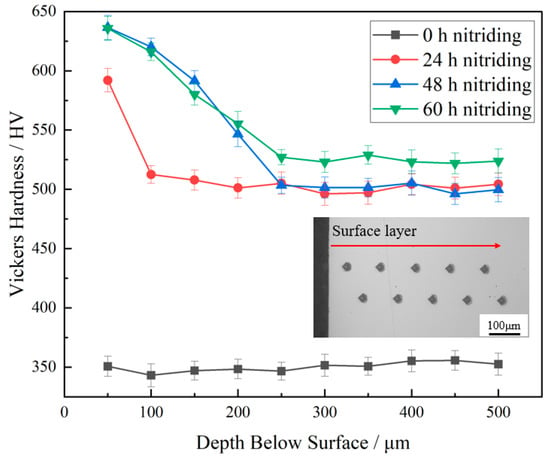
Figure 6.
Cross-sectional hardness variation curves of non-aged L-PBF manufactured 18Ni300 samples.
The test results show that the initial hardness of the samples is around 350 HV. After subsequent nitriding treatment, the surface hardness of the samples increases with the extension of nitriding time. The internal hardness of the samples continues to increase as the nitriding time increases; after 48 h of nitriding, the matrix hardness is approximately 505 HV, and when the nitriding time reaches 60 h, the matrix hardness of the samples is about 525 HV. The variation trend of the cross-sectional hardness of each sample is consistent with the metallographic structure results in Figure 3.
3.2.2. Cross-Sectional Hardness of Pre-Aged Specimen
The same hardness measurement method as in Section 3.2.1 was applied to the pre-aged samples, and the results showing the cross-sectional hardness variation are shown in Figure 7. The test results indicate that after the aging treatment, the sample hardness reached approximately 495 HV. Following the subsequent nitriding treatment, the surface hardness of the sample increased with the duration of nitriding. The internal hardness of the sample continued to increase with the duration of nitriding. After 48 h of nitriding, the matrix hardness was approximately 515 HV, and after 60 h of nitriding, the matrix hardness of the sample was approximately 530 HV. The trend of cross-sectional hardness variation in each sample was consistent with the metallographic structure results shown in Figure 4.
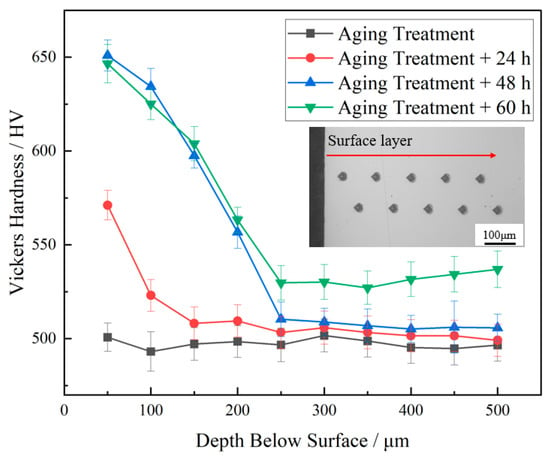
Figure 7.
Cross-sectional hardness variation curves of L-PBF 18Ni300 after different heat treatments.
The as-deposited microstructure of L-PBF manufactured 18Ni300 primarily consists of a supersaturated solid solution formed by rapid solidification, with a matrix hardness ranging from 300 HV to 400 HV []. After the aging treatment, the hardness increases due to the precipitation of the intermetallic compounds. Following the nitriding treatment, the further formation of metal nitrides such as FeN and CrN on the surface leads to a further increase in the surface hardness. As the nitriding time increases, needle-like structures form on the material surface (Figure 5). With further extension of the nitriding time, the surface hardness no longer continues to increase, which is because the surface can no longer generate additional metal nitrides to further enhance the surface hardness. The increase in internal matrix hardness with increasing nitriding time is attributed to the nitriding temperature of 500 °C, where the nitriding process can be regarded as a continuous aging treatment. Within this aging temperature range, intermetallic compounds continue to precipitate within the matrix, thereby further increasing the internal hardness of the material.
3.3. Wear Resistance
3.3.1. Wear Resistance of Non-Aged Specimen
Figure 8 illustrates the variation in the coefficient of friction (COF) of L-PBF 18Ni300 steel with sliding time. As depicted, the COF of the sample increases with nitriding time, from 0 to 48 h. However, when the nitriding duration reaches 60 h, the COF decreases instead. Although longer nitriding could increase surface roughness, at 60 h, the wear process might generate fine nitride debris or lubricious oxide products (e.g., Fe3O4, which has solid lubricant properties). These products can form a protective lubricating layer on the wear scar, offsetting the negative effect of the increased roughness and facilitating smoother sliding.
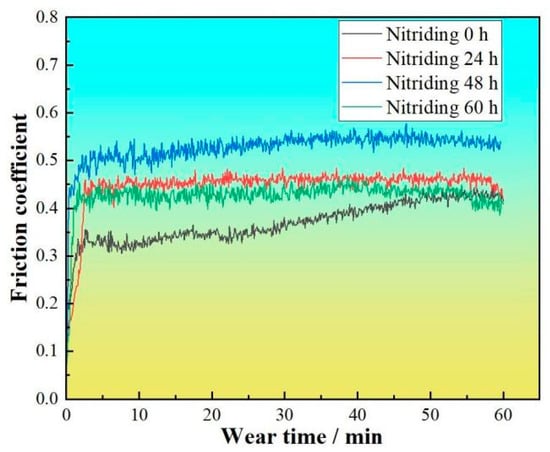
Figure 8.
Trend of friction coefficient for non-aged L-PBF 18Ni300.
Figure 9 illustrates the wear morphology of L-PBF 18Ni300 steel under varying nitriding durations. In the figure, a-1, b-1, c-1, and d-1 represent the macro-SEM images of wear morphology after nitriding for 0 h, 24 h, 48 h, and 60 h, respectively, while a-2, b-2, c-2, and d-2 correspond to the wear 3D topography after nitriding for 0 h, 24 h, 48 h, and 60 h, respectively. Macro-SEM images (a-1 to d-1) reveal that the un-nitrided (0 h) surface exhibits the deepest and widest wear scars, with pronounced plowing grooves and adhesive spalling. After nitriding, wear scars shallow significantly, and spalling areas diminish, indicating reduced wear severity. Three-dimensional topography (a-2 to d-2) further confirms this trend; the 0 h sample shows the maximum wear depth (~31 μm), while the nitrided samples (24 h, 48 h, 60 h) display markedly lower depths (~9–11 μm). The slight rebound in wear depth after longer nitriding (>24 h) may be attributed to the increased brittleness of the nitrided layer, leading to minor spalling during wear.
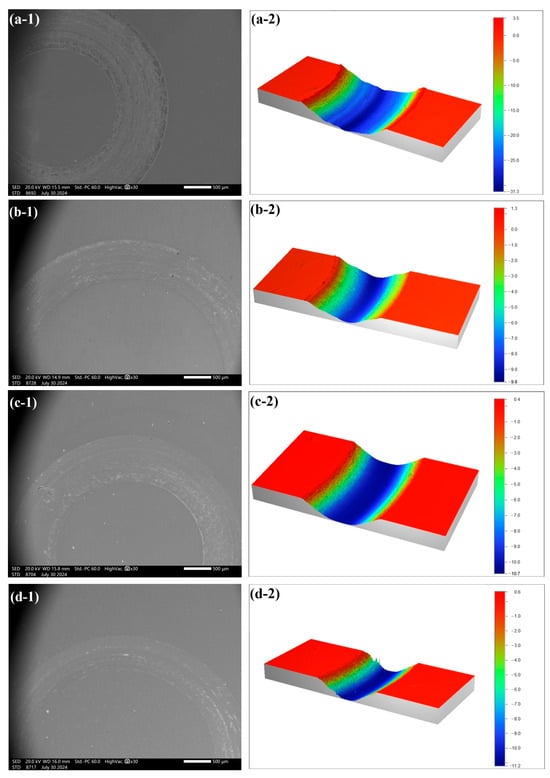
Figure 9.
The wear morphology of non-aged L-PBF 18Ni300 steel (a-1,a-2) 0 h, (b-1,b-2) 24 h, (c-1,c-2) 48 h, (d-1,d-2) 60 h.
Figure 10 illustrates the cross-sectional wear measurements of non-aged L-PBF 18Ni300 steel under varying nitriding durations. The trends in the widths and depths of the wear scars align with those in Figure 9; the 0 h sample exhibits the largest cross-section (depth: −29.798 μm), and the 24 h sample shows the smallest (depth: −9.043 μm), while the 48 h and 60 h samples display a slight rebound in cross-sectional dimensions yet remain significantly smaller than the 0 h baseline. This quantitatively confirms that nitriding markedly reduces the wear volume of L-PBF 18Ni300 steel, with the 24 h nitriding treatment yielding the optimal wear reduction efficiency.
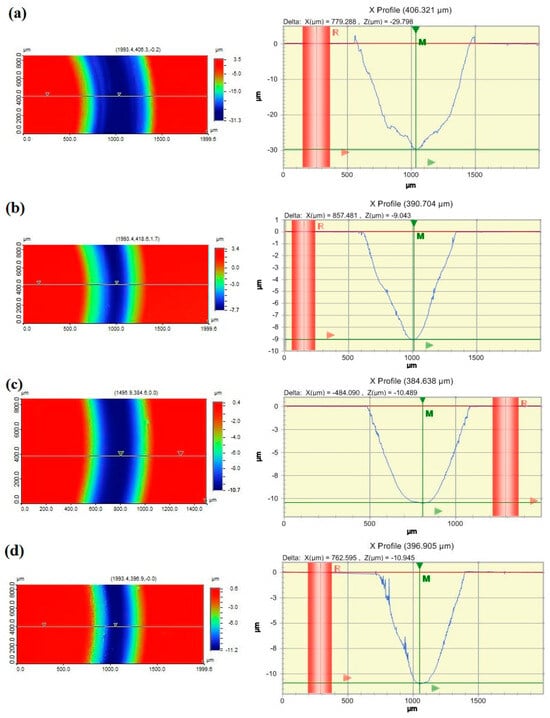
Figure 10.
The cross-sectional wear measurements of non-aged L-PBF 18Ni300 steel after (a) 0 h, (b) 24 h, (c) 48 h, and (d) 60 h.
The volume wear of each sample was calculated based on the three-dimensional wear contour results, and the volume wear rate was calculated using (1), as shown in Figure 11.
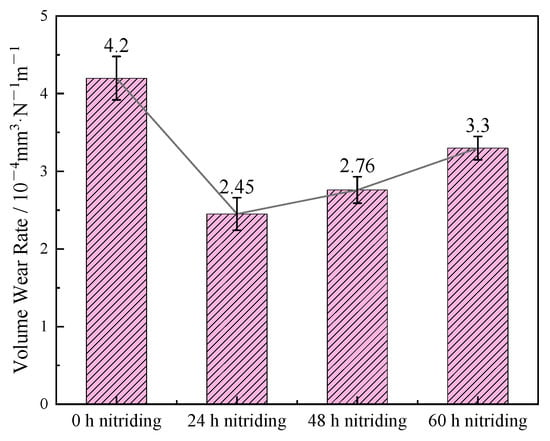
Figure 11.
Volume wear rate of non-aged L-PBF 18Ni300 samples.
The volume wear values of each sample were , , , and , respectively.
When non-aged samples are not subjected to solution and aging treatments, the matrix interior is mainly composed of an austenite structure. In this as-received state, the samples are less hard and are most susceptible to wear. After the nitriding treatment, nitrides such as FeN and CrN are directly formed on the surface layer, leading to an increase in surface hardness. However, for the samples nitrided for 24 h, during the friction and wear process, the surface layer material breaks and disperses on the wear scar surface. Under the continuous action of the counterpart ball, a lubricating film with a wear-reducing effect is formed on the wear scar surface, as shown in Figure 12a. Additionally, due to the relatively less hard the surface layer, the particles generated after the surface layer is damaged fail to remove the lubricating film. For samples nitrided for 48 h and 60 h, the harder surface layer causes the particles formed by surface damage during sliding to act as hard abrasive particles instead, which accelerate the wear process. Furthermore, a stable lubricating film region cannot be formed, as shown in Figure 12b. Therefore, as the nitriding time is extended, the wear is exacerbated instead.
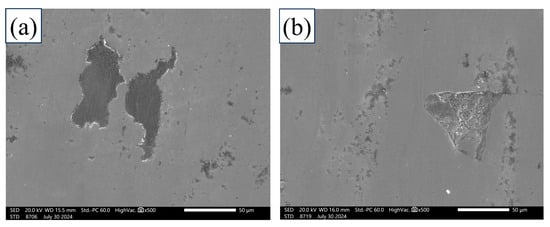
Figure 12.
The wear morphology of non-aged samples (a) 24 h nitriding, (b) 48 h nitriding.
3.3.2. Wear Resistance of Pre-Aged Specimen
Figure 13 shows the trend of friction coefficient variation for L-PBF 18Ni300 in ball-on-disk friction and wear tests after different heat treatments. The results indicate that the samples that receive only aging treatment and those that receive aging followed by 24 h of nitriding treatment have similar friction coefficients, at approximately 0.32. As the nitriding time increases, the friction coefficient of the samples also increases, reaching a maximum of about 0.48 after 60 h of nitriding treatment.
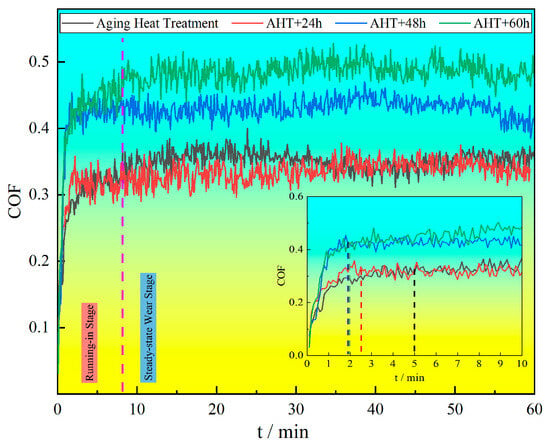
Figure 13.
Trend of friction coefficient for pre-aged L-PBF 18Ni300.
The sliding friction and wear process is divided into an early running-in stage and a subsequent stable wear stage []. For each sample, the friction coefficient curve during the stable wear stage shows minimal fluctuation, indicating a relatively smooth overall wear process on the sample surface. However, the running-in stage varies with the heat treatment method. The results show that the samples that receive only the aging treatment have the longest running-in stage, taking approximately 5 min to enter the stable stage. In contrast, the samples after nitriding treatment exhibit a significantly reduced running-in stage. The samples that receive aging +24 h nitriding treatment have a running-in stage of about 2.5 min, while the samples that receive 48 h and 60 h nitriding treatments have similar running-in stages, lasting about 2 min. The increased friction coefficient and the significantly shortened early running-in stage for the nitrided samples are primarily due to the rougher surface of the nitride samples compared to on the aged samples. As the nitriding time increases, more metal nitrides and intermetallic compounds precipitate on the sample surface. Additionally, to avoid damaging the surface nitride layer, the samples are not polished again before the friction and wear test, leading to the higher friction coefficient and the shorter running-in stage.
Figure 14 shows the surface wear scar morphology and profiles of L-PBF 18Ni300 samples after friction and wear tests with different heat treatments. The results indicate that the sample receiving only aging treatment has the widest wear scar and the deepest depth, while the sample receiving aging treatment +48 h nitriding has the narrowest wear scar and the shallowest depth.
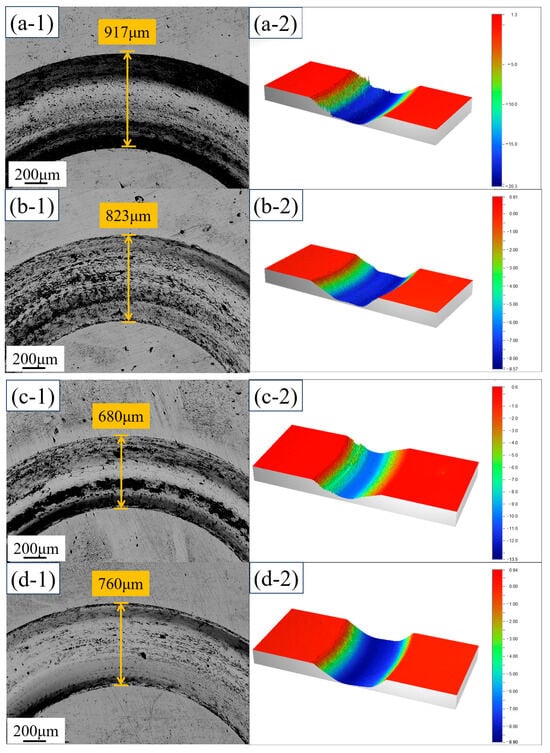
Figure 14.
The wear morphology of pre-aged L-PBF 18Ni300 steel. (a-1,a-2) Aging treatment; (b-1,b-2) aging +24 h nitriding; (c-1,c-2) aging +48 h nitriding; and (d-1,d-2) aging +60 h nitriding.
Figure 15 presents the cross-sectional wear measurements of pre-aged L-PBF 18Ni300 steel under different nitriding durations. The variations in the wear scar width and depth correspond to those in Figure 14; the aging-only sample (0 h nitriding) shows the largest cross-section (depth: −19.636 μm) and the aging +24 h nitriding sample exhibits the smallest (depth: −7.992 μm), while the 48 h and 60 h samples display a slight increase in cross-sectional dimensions, yet remain notably smaller than the aging-only baseline.
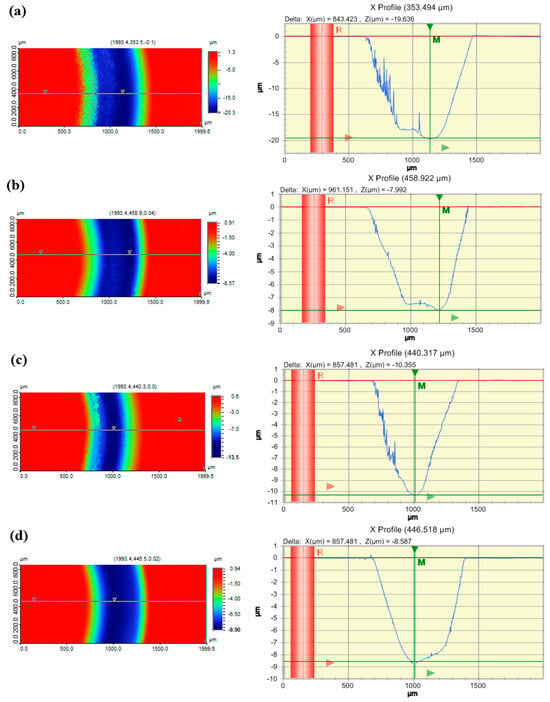
Figure 15.
The cross-sectional wear measurements of pre-aged L-PBF 18Ni300 steel. (a) Aging treatment; (b) aging +24 h nitriding; (c) aging +48 h nitriding; and (d) aging +60 h nitriding.
The volume wear of each sample was calculated based on the three-dimensional wear contour results, and the volume wear rate was calculated using (1), as shown in Figure 16.
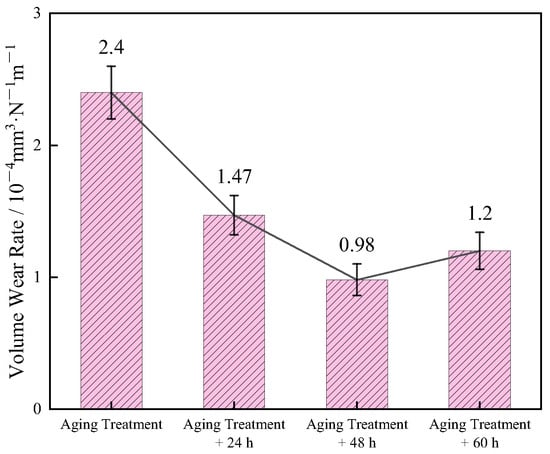
Figure 16.
Volume wear rate of L-PBF 18Ni300 samples after different heat treatments.
The volume wear values of each sample were , , , and , respectively. The friction and wear results indicate that the sample that received 48 h of nitriding after aging treatment had the best wear resistance. However, the further increase in the nitriding time led to a decrease in wear resistance, which may be related to the surface condition of the material. During the aging treatment, nanoscale intermetallic compounds (Ni3Ti, Ni3Mo, Fe2Mo, etc.) precipitate, which effectively enhances the hardness of the material. After the subsequent nitriding treatment, the hardness of the material becomes the dominant influencing factor—generally, the greater the hardness, the higher the wear resistance of the material. Notably, the wear volume of the sample increased, instead, after 60 h of nitriding. This can be attributed to the continuous precipitation of nitride phases in the surface region during the prolonged nitriding process, which leads to a significant increase in the surface roughness. When the hardness of the material fails to further increase, the rougher surface morphology intensifies the abrasive and adhesive wear between the friction pairs. This phenomenon further explains why the friction coefficient of the sample, after 60 h of nitriding, shows an increasing trend compared with that of the sample after 48 h of nitriding.
A comparison of wear resistance between the non-aged and pre-aged sample specimens demonstrates the decisive influence of the pretreatment processes on the nitriding strengthening efficacy in L-PBF 18Ni300 steel. The non-aged samples, characterized by a supersaturated solid solution matrix (300–400 HV), achieve minimal wear depth (−9.043 μm) after 24 h of nitriding, whereupon the thin nitride layer synergizes with the soft matrix to form a buffer zone that mitigates crack propagation under wear stress. However, prolonged nitriding induces layer embrittlement, leading to performance degradation. In contrast, pre-aged pretreatment samples feature a hardened matrix (495 HV), optimized by precipitated intermetallic compounds. After 48 h of nitriding, these samples develop a 211 μm thick nitride layer, establishing a hardness gradient (650 HV→510 HV) that cooperatively resists plastic deformation and adhesive wear, resulting in the shallowest wear scars. These findings quantitatively confirm that nitriding parameters must align with the matrix state; short nitriding (24 h) optimally suits the un-aged state, while prolonged nitriding (48 h) is essential for the aged state to maximize wear resistance.
4. Conclusions
The study on the microstructure and wear resistance of L-PBF 18Ni300 after heat treatment and nitriding indicates the following:
(1) The composite process of pre-aging and nitriding significantly optimizes the hardness and quality of the nitride layer by regulating the synergistic effects between potential matrix precipitates and nitrogen diffusion kinetics, forming an organized structure in the surface layer of L-PBF 18Ni300 steel that is characterized by a fine-grained martensite substrate with uniformly dispersed high-density nanoscale structures.
(2) The composite process of pre-aging and nitriding achieves continuous gradient strengthening from the surface to the core, effectively overcoming the interfacial spalling risk inherent in conventional nitriding.
(3) Based on the synergistic strengthening mechanism mentioned above, nitriding parameters for L-PBF 18Ni300 steel must align with the matrix state. Non-aged steel should adopt a 24 h, short nitriding process, relying on a thin nitride layer to achieve preliminary strengthening, while steel subjected to pre-aged pretreatment requires 48 h, prolonged nitriding to attain optimal surface performance through the synergistic interaction of a “nitride-strengthened layer + aged matrix support” mechanism.
Author Contributions
Conceptualization, X.G. and Z.M.; methodology, X.G., Z.M. and Z.J.; software, C.C. and Z.M.; validation, Q.K., Z.J. and C.C.; data curation, X.G. and Q.K.; writing—original draft preparation, X.G., C.C. and Q.K.; writing—review and editing, Z.M. and Z.J. All authors have read and agreed to the published version of the manuscript.
Funding
This research was funded by Chengdu Aeronautic Polytechnic Major Scientific Research Projects (grant no. ZZX0623067).
Institutional Review Board Statement
Not applicable.
Informed Consent Statement
Not applicable.
Data Availability Statement
The original contributions presented in this study are included in the article; further inquiries can be directed to the corresponding author.
Conflicts of Interest
Author Quan Kang was employed by the company Chengdu Runbo Technology Co., Ltd. The remaining authors declare that the research was conducted in the absence of any commercial or financial relationships that could be construed as a potential conflict of interest.
References
- Zhou, Y.; Wang, F.; Xue, C. Microstructure and mechanical properties of 3D printing 18Ni300 die stee. Phys. Test Chem. Anal. Part A Phys. Test. 2016, 52, 243–246. [Google Scholar]
- XU, D.; CHEN, Y.; XU, H.; Xu, C.; Pu, C. Research progress of ultra-high strength maraging stee. J. Netshape Form. Eng. 2021, 13, 100–108. [Google Scholar]
- Gu, D.; Zhang, H.; Chen, H.; Zhang, H.; Xi, L. Laser additive manufacturing of high-performance metallic aerospace components. Chin. J. Lasers 2020, 47, 32–55. [Google Scholar] [CrossRef]
- Gu, D.; Meiners, W.; Wissenbach, K. Laser additive manufacturing of metallic components: Materials, processes and mechanisms. Int. Mater. Rev. 2012, 57, 133–164. [Google Scholar] [CrossRef]
- Cuesta, E.; Alvarez, B.J.; Zapico, P. Analysis of post-processing influence on the geometrical and dimensional accuracy of selective laser melting parts. Rapid Prototyp. J. 2020, 26, 1713. [Google Scholar] [CrossRef]
- Li, X. Investigation on the SLM Forming Mechanism and Super Hydrophobicity of the FeCrMoCBSiS Amorphous Alloy. Master’s Thesis, Jilin University, Changchun, China, 2023. [Google Scholar]
- Tan, C.L.; Zhou, K.S.; Ma, W.Y. Microstructural evolution, nanoprecipitation behavior and mechanical properties of selective laser melted high-performance grade 300 maraging steel. Mater. Des. 2017, 134, 23–34. [Google Scholar] [CrossRef]
- Zhong, L.; Wang, S.; Men, X. Research on plasma nitriding process of 38CrMoAl Steel with Ti Catalyst. Surf. Technol. 2021, 50, 159–166. [Google Scholar]
- Karliński, W.; Tacikowski, J.; Wojtyra, K. Fatigue strength of nitrided 18Ni250 and 18Ni300 grade maraging steels. Surf. Eng. 1999, 15, 483–489. [Google Scholar] [CrossRef]
- Tsyrliné, S. Nitriding of maraging steel N18K9M5T. Met. Sci. Heat Treat. 1971, 13, 289–292. [Google Scholar] [CrossRef]
- Hu, N. The Effect of Nitriding Process on the Mechanical Properties of 18Ni Maraging Steel. Master’s Thesis, Kunming University of Science and Technology, Kunming, China, 2017. [Google Scholar]
- Bai, Y.C.; Wang, D.; Yang, Y.Q. Effect of heat treatment on the microstructure and mechanical properties of maraging steel by selective laser melting. Mater. Sci. Eng. A 2019, 760, 105–117. [Google Scholar] [CrossRef]
- Men, Z. Effect of heat treatment on the microstructure and mechanical properties of 18Ni300 stainless steel melted by laser selective melting. Appl. Laser 2022, 42, 29–36. [Google Scholar]
- Dong, F.; Zhang, M.; Hou, J. Effect of aging time on microstructure and mechanical properties of SLM 18Ni300 maraging steel. Heat Treat. Met. 2021, 46, 88–91. [Google Scholar]
- Han, L.; Zhao, C. Study on fast plasma nitriding technology of 40Cr steel with nitrogen-rich layer. Trans. Mater. Heat Treat. 2009, 30, 124–128. [Google Scholar]
- Bai, J.; Men, Z.; Su, Y. Effects of aging heat treatment on friction and wear behaviors of selective laser-melted 18Ni300. J. Netshape Form. Eng. 2023, 15, 164–172. [Google Scholar]
- Chen, C.; Men, Z.; Ma, Y. Friction and wear characteristics of 18Ni300 prepared by selective laser melting. Appl. Laser 2022, 42, 72–80. [Google Scholar]
- Xiao, L.; Gao, C. Nitriding of Steel; China Machine Press: Beijing, China, 1989. [Google Scholar]
- Geng, Y.; Tang, H.; Xu, J. Formability and mechanical properties of high-strength Al-(Mn, Mg)-(Sc, Zr) alloy produced by selective laser melting. Acta Metall. Sin. 2022, 58, 1044–1054. [Google Scholar]
- Xue, J.; Sun, K.; Fang, L. Friction and wear characteristics of 30CrMnSiNi2A steel at dry sliding condition. Tribology 2016, 36, 614–621. [Google Scholar]
Disclaimer/Publisher’s Note: The statements, opinions and data contained in all publications are solely those of the individual author(s) and contributor(s) and not of MDPI and/or the editor(s). MDPI and/or the editor(s) disclaim responsibility for any injury to people or property resulting from any ideas, methods, instructions or products referred to in the content. |
© 2025 by the authors. Licensee MDPI, Basel, Switzerland. This article is an open access article distributed under the terms and conditions of the Creative Commons Attribution (CC BY) license (https://creativecommons.org/licenses/by/4.0/).